13 Tips For The Best Homemade Salsa
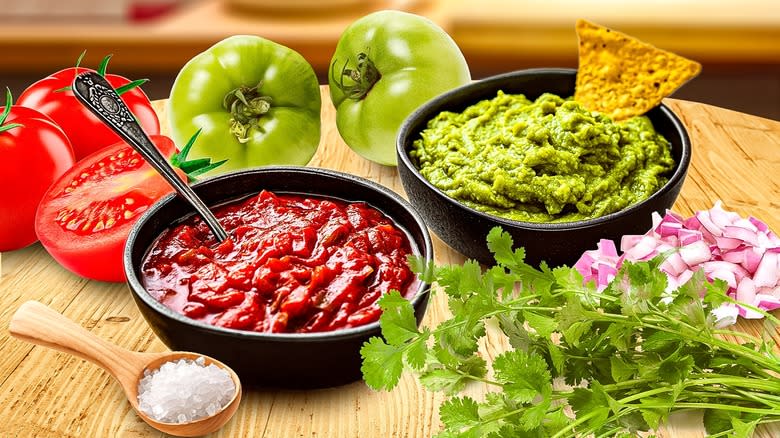
A good salsa is flavorful, complex, addictive, and as at home on a tortilla chip as it is smothering a burrito. Although grocery store shelves are packed to the brim with jarred and canned varieties from all over the country, creating a delicious and memorable salsa at home is easier than you may think -- be it a savory pico de gallo or sweet fruit salsa highlighting seasonal fruit.
Hailing from Mexico and generally referring to anything from roasted chunky dips to simple, smooth tomato-based sauces, salsa is synonymous with endless dipping in a bowl of fresh, bright flavors. To create the best homemade salsa, it's important to keep a few tips and tricks in mind. From seasoning every step of the way to leaning into acidity and never saying no to fresh herbs. Here are some tips to help you execute the most delicious homemade salsa to wow your guests and yourself.
Read more: The 15 Healthiest Chip Brands, Ranked From Worst To Best
Acidity Is Needed For Fresh Or Canned Salsa
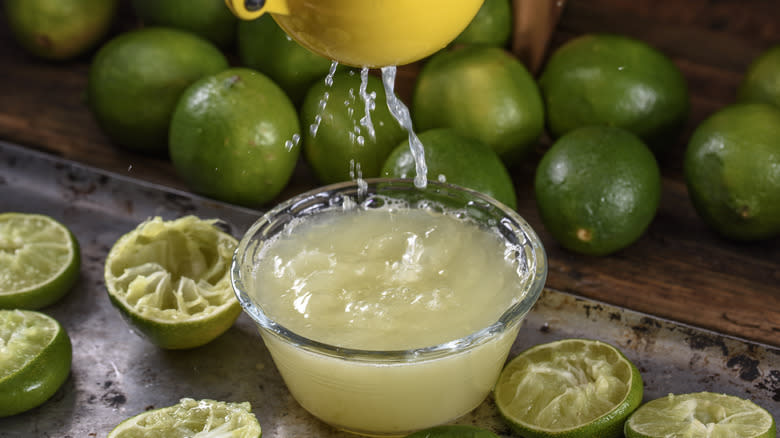
One thing that your homemade salsa absolutely needs is acid. Whether it's lemon juice, vinegar, or lime juice, the addition of an acid helps to lift and brighten all of the flavors in your salsa.
Think about when you're creating a simple tomato salad: One of the main finishing ingredients after herbs like basil, parsley, or thyme is to sprinkle a bit of either red wine vinegar or balsamic vinegar. The acid helps to tame the extra virgin olive oil's fattiness while lifting the tomatoes' sweetness.
The same is true for salsa. In this case, though, it's best to steer toward acids like citrus or a less flavorful vinegar -- think more white or red wine and less balsamic or apple cider. Many culinarians actually swear by plain, white vinegar in salsa, as they feel it brightens the components without becoming an overpowering ingredient in your salsa and detracting from any of the delicate vegetal flavors. If you're going the citrus route, fresh is best. Break out that fancy juicer you've never used and put it to work. In terms of quantity, you won't need much; go with about four tomatoes to one lime ratio like this recipe. The golden rule is to taste as you go.
Choose The Right Tomatoes And Remove The Seeds
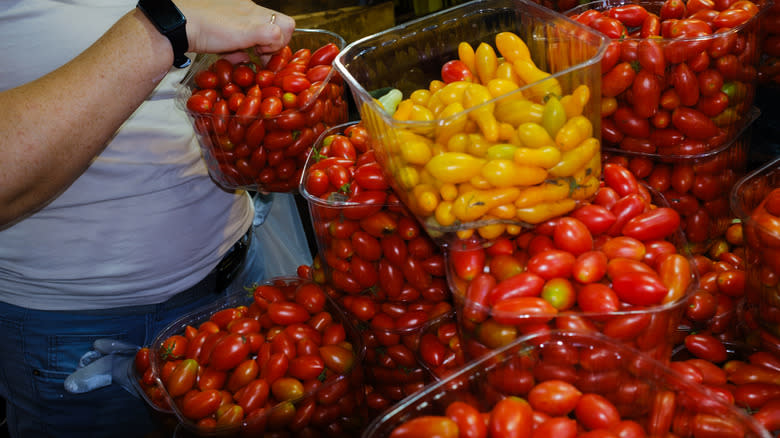
From misshapen but delicious heirlooms to tiny tart cherries and versatile Romas, tomatoes come in a huge variety of shapes, colors, and flavors. Choosing the right tomato for your salsa depends entirely on the kind of flavor profile you're after.
The best tomatoes for your salsa should be flavorful, have few seeds since they should be removed, and be budget-friendly. An heirloom tomato, for example, is too expensive for most of us to be either throwing in a blender or rough chopping into a salsa. They also can have tons of seeds, which makes for a waste of an ingredient.
Plum tomatoes and the classic Roma tomatoes are both solid, budget-friendly, and flavorful options for your salsa. Romas are great for raw varieties of salsa since they have a good tomatoey flavor and not many seeds. They also tend not to hold too much juice, so your salsa won't become a soggy mess. Plums are a better choice for roasting since their flavor tends to concentrate during the process.
Why remove the seeds from your tomatoes? It's actually an extra step to amplify your salsa. The seeds they're accompanying membrane will begin to break down the longer the salsa sits, diluting the flavor of your dish and making everything rather wet.
Fresh Herbs Are Greater Than Dried
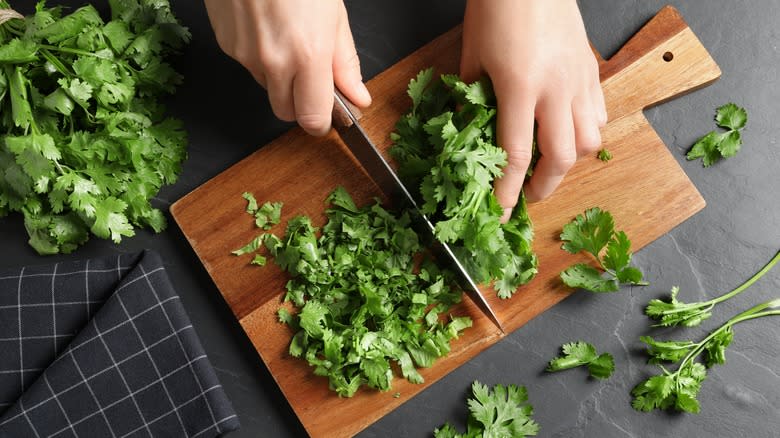
If you're leaning into soup season, stew season, or slow-simmer season, dried herbs are your bestie. They tend to release their aromatics over time and have a more potent flavor, making them great for longer cooking or baking times. Fresh herbs, on the other hand, still have their water content, making their flavors a bit less concentrated and better for uncooked dishes like salsa. Adding dried herbs to fresh salsa would result in an overtly powerful herb flavor; drowning out the other notes you're trying to promote in your dish.
In terms of tips for fresh herbs and what should be utilized in your salsa, cilantro tends to be king. The refreshingly light, bright, and earthy flavor of cilantro makes it a natural pair with common salsa ingredients like lime juice and tomato. Of course, cilantro tastes like soap to some people (for which genetics are to blame), so if that's the case, you can use it very sparingly or not at all. If you're creating a fruit-forward salsa, you can also incorporate cilantro, but fresh mint (not spearmint) can be a wonderful addition.
Add Heat, But Not Too Much
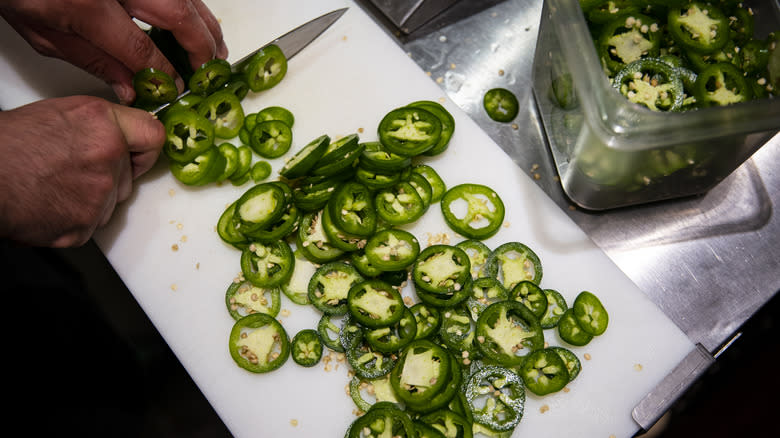
Some home cooks may pride themselves on creating a salsa so hot, that only the bravest of culinarians can eat more than one bite. But a blow-you-away experience isn't usually an enjoyable one, so a solid tip for creating a good salsa is to use heat, but keep it tame enough that your flavors shine through.
Most cooks, when creating a well-rounded salsa, will reach for the small, green jalapeño pepper. The pepper is crisp, crunchy, bright, and holds a heat that's consistent from the first bite until the salsa is gone. It's upfront and less of a slow burn or an immediate fire in your mouth. For mild heat, the seeds and ribs can be completely removed. For more heat, both can be left in and finely chopped. One step up from a jalapeño, the habanero can be deftly used as a burst of heat and fruitiness in your salsa, but be careful: these peppers are exponentially hotter than the jalapeño.
Choose The Right Kind Of Onions

Like choosing the right kind of tomatoes, choosing the right kind of onion can make or break the specific type of salsa you're working to create. Navigating the multiple varieties, though -- red, Vidalia, yellow, sweet, etc. -- can be daunting.
In Mexico, if you're served a dish of salsa, more than likely it'll have been made with finely diced white onions. White onions are subtle, but still carry the onion flavor needed to add some zing to the rest of your salsa. They also hold their shape and their crunch -- a necessary element for a salsa that gains flavor as it sits and marinates. Lastly, they won't make your eyes water in the same way a yellow onion would; and they certainly won't add the sometimes overpowering bite of a red onion (or start dying your salsa purple).
If you're not a white onion fan, or if you're looking for something outside the tomato-based salsa, a salsa criolla relies on marinated red onions and herbs, sort of ceviche style. The Peruvian specialty is wonderful on fish tacos or rich meats, where the acidity of the onions helps to cut fattiness.
Choose The Right Chip

Once your tomatoes are chopped, your hands are washed clean of jalapeno seeds, and your salsa has had ample time to marinate and come together, how to serve your dish becomes top of mind. But the choice of chip is much more nuanced than just pouring tortillas out of a bag picked up from the grocery store. Choosing the best chip to pair with your salsa depends on the type of salsa you've created and the vibe you're going for.
The absolute best chip for any salsa is homemade. By cutting up corn tortillas and quickly shallow frying, draining, and sprinkling with sea salt, you'll have a fresh, warm chip the likes of which you'd see in most Mexican restaurants.
If time isn't on your side and making your own chips isn't on the schedule, a few store-bought tortilla chip varieties are better than others. First, if your grocer offers tortilla chips fried on-site, those should be your first choice. If not, peruse the chip aisle for anything "cantina-style" or "restaurant-style" that are thick enough to hold a sturdy, chunky salsa.
It Needs Time To Marinate
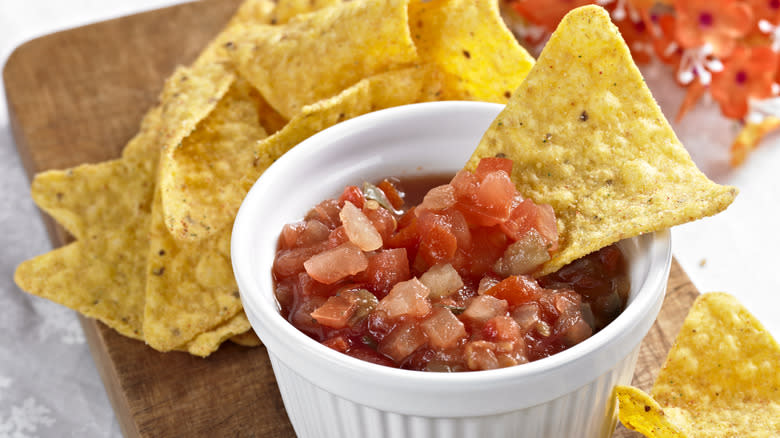
Salsa is not a dish to be rushed, even though its raw nature and quick execution time make it a prime candidate for emergency company. But one of the worst things you can do is not give your salsa time to rest. Like a fancy steak, salsa needs time for its flavors to get acquainted. You've introduced everything from salty to acidic to sweet in however long it's taken to get your ingredients together. Let your components have a chance to breathe.
So, how long does your salsa need to sit? At least an hour at room temperature is your best bet. If, of course, you just don't have that kind of time, 30 minutes should do. In that time, too, try your best not to continually mix or mess with your salsa in any way. If you're dealing with something that uses avocados, continuously poking or prodding your salsa will cause your veggies to break down faster, leading to a watery mess. Once it's time to (finally) tuck into your homemade salsa, if it's become a bit watery, drain off a bit before serving to protect those crunchy chips from becoming soggy.
Don't Be Afraid To Add Sweetness
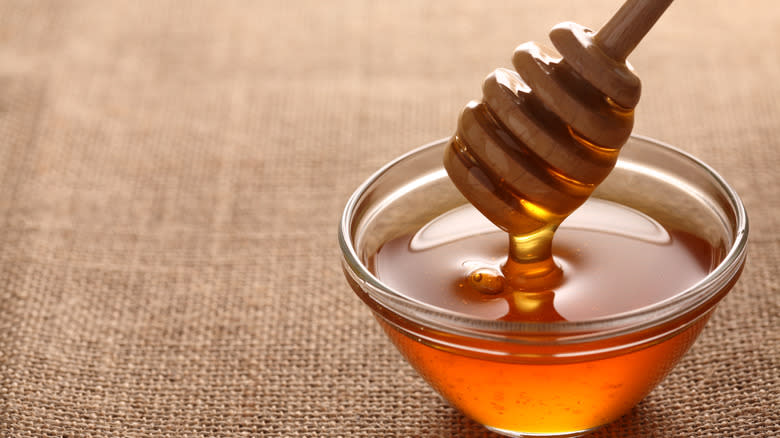
Although it seems like salsa is synonymous with tomatoes, chiles, and savory flavors, a bit of sweetness can be a welcome change when creating this dip. The first way to add sweetness is by incorporating a little bit of fruit. Not every salsa and not every fruit works here, but say, for example, you're creating a salsa for your fish tacos. Instead of going the pico de gallo route, go for a mango avocado guacamole. The sweet brightness of the mango complements the earthy coolness of the avocado, and lime juice works beautifully with both flavors. Simply create your guacamole as usual, but before serving add a very ripe, diced mango. Aside from being yummy, this execution brings together the healthy omega-3 fatty acids of the avocado with high levels of vitamins A, C, and K from the mango.
If you aren't as into the idea of serving a fruit salsa, incorporating sweetness by way of agave nectar, honey, or sugar is equally a good idea. Hot, spicy, and savory are all tasting notes common in salsa, and they can become a bit monotonous bite after bite. To balance the unctuousness, add a bit of your desired sweetener to taste. Pro tip: Grilled, charred, and fire-roasted salsas benefit from the addition of sweetness exponentially well.
Salt And Season Every Step
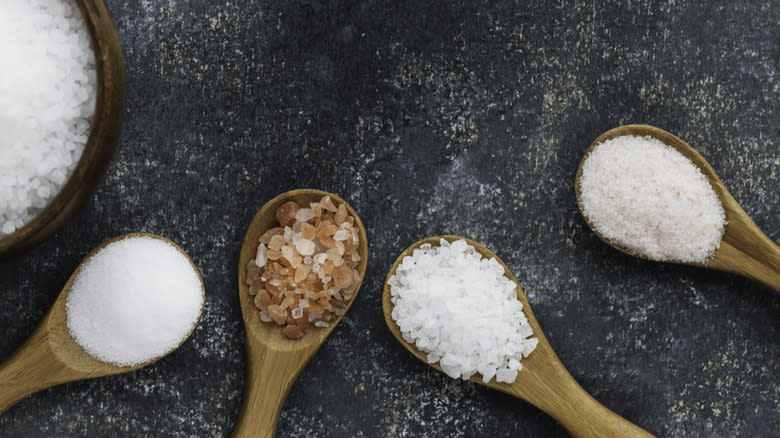
As with most great dishes in life, salsa demands to be seasoned every step of the way. From your base ingredient of tomatoes, mango, or avocado to your finishing step of adding fresh herbs, salt should be at the ready for seasoning.
In terms of what kind of salt your salsa needs, it's really up to your own discretion. A pink Himalayan salt, for example, may have more health benefits in the way of minerals than regular table salt, but you'll get very little difference in flavor. Black salt is pungent, almost sour, and imparts a sort of umami vibe that could be interesting in a salsa criolla or guacamole. But be careful -- the black salt can seep into your salsa and leave a charcoal-like residue.
The safest option for your salsa that's easily accessible and beloved by all? Kosher salt. The larger crystals and lack of additives make it a great choice, and the size makes it easy to add a "pinch" at every step -- tasting as you go.
Temperature, Whether Hot Or Cold, Is Important
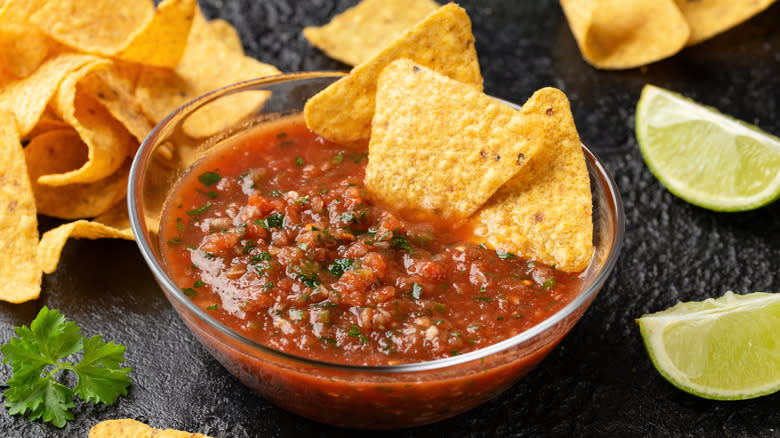
You may be in the habit of reaching into the refrigerator for your favorite jarred salsa and dipping tortilla chips straight into the container -- no waiting. However, it may surprise you to know that this is not the correct way to eat salsa; and the rules about temperature apply to your homemade version, too.
Think of your tomatoes: you probably know to not refrigerate those heirloom beauties and, instead, leave them on your countertop until it's time to slice them and serve. The refrigerator doesn't necessarily hurt the tomatoes, but it blunts the flavor to et them cold. Since many salsas are tomato-based, you'll want to let them come to room temperature before serving so as to get the most bang out of your flavors -- especially if you've taken the time to really marinate everything. If your salsa isn't tomato-based, it's still a good idea to let it come to room temperature for about 10 to 30 minutes before enticing your guests to dig in.
Chop, Process, And Blend Depending On The Ingredient
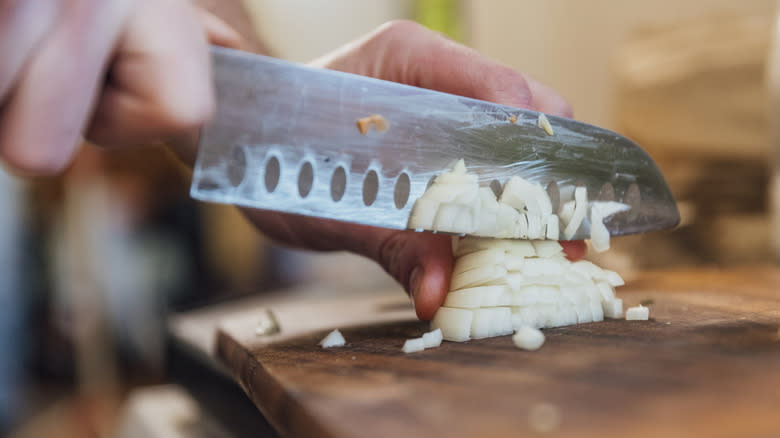
As with any recipe, treating every ingredient the same in processing isn't usually the best course of action. There are a few critical mistakes people can make when blending salsas at home when they should be dicing, chopping, or tearing an ingredient instead.
For example, you'll want to finely chop your onion instead of blending it. Over-processing onions can make them extra, well, juicy. That juice can eek into your salsa, overpowering sweet tomatoes and delicate herbs. Garlic, if you're using it, can be processed as can any chiles. Processing both or either of these ingredients will help prevent you or your guests from biting into big spicy chunks, which we all know can turn you off from a second and third bite.
As for tomatoes and tomatillos, you can chop and de-seed by hand if you want more of a pico de gallo salsa. Blending is fine if you're looking for a smoother salsa, as it'll give you more of a cantina-style, saucy salsa.
Experiment With Fire
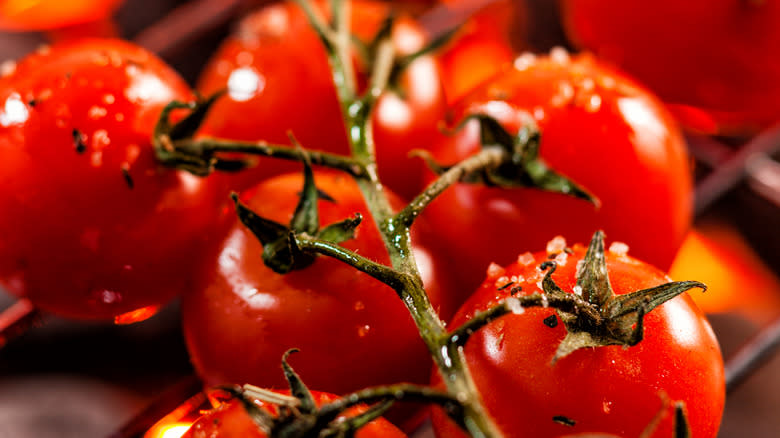
Experimenting with fire isn't usually something we'd be advising but in the event of salsa, playing with charring and grilling your components is actually a great way to add a layer of flavor.
If your plan was to make a basic pico de gallo, take your salsa to the next level by charring your tomatoes, onions, and peppers instead of just dicing and going straight into the bowl. In a cast iron skillet, blacken your plum tomatoes, jalapenos, garlic, and onion -- working in batches until everything is toasted and blackened. Throw everything into a blender and pulse with lime, agave, and cilantro until you reach the desired consistency. Then, season with salt and pepper.
You can also opt only to blacken certain components of your salsa. In a salsa verde, you could roast tomatillos and onions until browned and golden but leave your herbs, chiles, and garlic raw. It'll add a new dimension of flavor to your salsa and level up from the basics.
Of course, if you don't have time for roasting in the oven, grilling, or messing up your cast iron pan, you can purchase cans of fire-roasted tomatoes in the grocery store and have half the work done for you. If you do go the canned direction, though, make sure the rest of your ingredients are fresh so as to disguise the sometimes metallic taste of prepackaged tomatoes.
Add Something Fatty
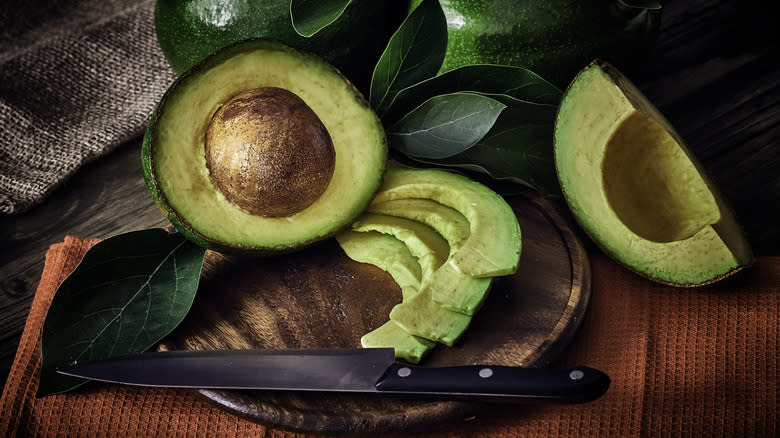
Although it isn't always necessary, including olive oil or avocado in your salsa adds a cooling, unctuous element that helps to balance the savory, spicy aspects of your salsa.
Let's say you misjudged your jalapenos as being less spicy than they actually are. Maybe you even went so far as to leave the ribs and seeds in before mixing everything together. If you feel like you've made a terrible mistake, the addition of avocado can help cool the fire you've created. Avocado will also impart a new, soft, natural texture, and provide healthy omega-3 fatty acids to your creation. Olive oil won't do much to tame the heat in your salsa, but it will bring a fruity, savory note that will elevate your dish further.
You could also add peanut butter to change your salsa forever. Yes, you read that right. Spooning in everyone's favorite sandwich companion can tame the heat from chiles and add an earthy nuttiness that's right at home on dishes like carne asada.
Read the original article on Tasting Table.

